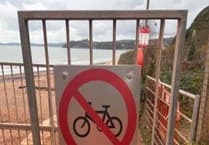FOUR ‘important safety messages’ have been issued following a ‘near miss’ with a train at Teignmouth that could have resulted in a fatal accident with a railway worker.
A report into the incident by the Rail Accident Investigation Branch has been published today, Thursday.
The report describes the worker’s close brush with tragedy: ‘At around 01:23 hrs on 14 February 2023, a passenger train travelling at 55 mph (88 km/h) narrowly missed a track worker on the down main line near Teignmouth Station.
‘The track worker involved was placing a work site marker board on the six-foot rail of the down main when the near miss occurred.
‘Although uninjured, the track worker was forced to jump into an adjacent line to avoid being struck.
‘The train involved collided with the work site marker board less than two seconds after the track worker jumped clear.’
The report said the incident occurred because the track worker had incorrectly assumed that the down main line they were placing the marker board on had been blocked to rail traffic.
Although the marker board was placed following several conversations between the track worker and the responsible Engineering Supervisor (ES), none of these conversations prevented the incident from occurring.
The near miss occurred close to Teignmouth Station during the setting up of a work site (a portion of line where work will take place) and at a location where access to the railway was through a private boat yard.
This was part of a regular series of similar arrangements put in place so road-rail vehicles (RRVs) and an overhead crane could have access during the construction of a new rockfall shelter over the Great Western Main Line.
‘This incident occurred because the informal method of communication had led to two assumptions being made.
‘These were the assumption made by the track worker that the line was already blocked, when being asked to set up the work site marker boards, and the assumption by the ES that the track worker would await further instructions before accessing the railway.
‘This informal communication between the track worker and ES arose due to their familiarity with each other, their good working relationship and because they had been applying the same work site arrangements almost every night for several months.
The report highlights the following ‘safety messages’
This incident demonstrates the importance of:
Not undertaking tasks that require members of staff to access the railway unless those tasks are unavoidable.
Reaching a clear understanding about the operational status of the railway before going on or near the line.
Following good safety-critical communications practice regardless of the regularity of the arrangements being made or mutual familiarity of the staff involved.
Prompt use of the train warning horn, which in this case probably avoided a fatal accident.
A Network Rail spokesperson said, ‘This was a serious incident where a railway worker could have been badly injured, or worse.
‘As a safety critical company, we work hard to prevent this type of incident from happening, but we recognise there is always room for improvement, and lessons will be learnt from this.
‘We have already shared the outputs of an internal review, and will also be sharing the findings of the RAIB report with colleagues.’
Read the report
You can read the report at:





Comments
This article has no comments yet. Be the first to leave a comment.